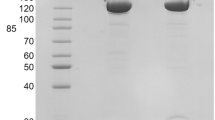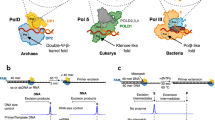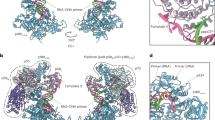Abstract
Primases synthesize the RNA primers that are necessary for replication of the parental DNA strands. Here we report that the heterodimeric archaeal/eukaryotic primase is an iron-sulfur (Fe-S) protein. Binding of the Fe-S cluster is mediated by an evolutionarily conserved domain at the C terminus of the large subunit. We further show that the Fe-S domain is essential to the unique ability of the eukaryotic primase to start DNA replication.
This is a preview of subscription content, access via your institution
Access options
Subscribe to this journal
Receive 12 print issues and online access
$189.00 per year
only $15.75 per issue
Buy this article
- Purchase on Springer Link
- Instant access to full article PDF
Prices may be subject to local taxes which are calculated during checkout


Similar content being viewed by others
References
Kornberg, A. & Baker, T.A. DNA Replication 2nd edn. (W.H. Freeman and Company, New York, 1992).
Frick, D.N. & Richardson, C.C. Annu. Rev. Biochem. 70, 39–80 (2001).
Foiani, M., Santocanale, C., Plevani, P. & Lucchini, G. Mol. Cell. Biol. 9, 3081–3087 (1989).
Foiani, M., Lindner, A.J., Hartmann, G.R., Lucchini, G. & Plevani, P. J. Biol. Chem. 264, 2189–2194 (1989).
Copeland, W.C. Protein Expr. Purif. 9, 1–9 (1997).
Schneider, A. et al. J. Biol. Chem. 273, 21608–21615 (1998).
Arezi, B., Kirk, B.W., Copeland, W.C. & Kuchta, R.D. Biochemistry 38, 12899–12907 (1999).
Zerbe, L.K. & Kuchta, R.D. Biochemistry 41, 4891–4900 (2002).
Copeland, W.C. & Wang, T.S. J. Biol. Chem. 268, 26179–26189 (1993).
Matsui, E. et al. Biochemistry 42, 14968–14976 (2003).
Liu, L. et al. J. Biol. Chem. 276, 45484–45490 (2001).
Lao-Sirieix, S.H., Nookala, R.K., Roversi, P., Bell, S.D. & Pellegrini, L. Nat. Struct. Mol. Biol. 12, 1137–1144 (2005).
Conaway, R.C. & Lehman, I.R. Proc. Natl. Acad. Sci. USA 79, 2523–2527 (1982).
Tseng, B.Y. & Ahlem, C.N. J. Biol. Chem. 257, 7280–7283 (1982).
Kaguni, L.S., Rossignol, J.M., Conaway, R.C. & Lehman, I.R. Proc. Natl. Acad. Sci. USA 80, 2221–2225 (1983).
Singh, H. et al. J. Biol. Chem. 261, 8564–8569 (1986).
Sheaff, R.J. & Kuchta, R.D. Biochemistry 32, 3027–3037 (1993).
Acknowledgements
We thank R. Nookala and M. Lyst for early work on the S. solfataricus PriL-CTD, J. Crack (University of East Anglia) for advice on iron-sulfur biochemistry, J. Downs (University of Sussex) for the gift of yeast genomic DNA, I. Gomez-Morillo for help with the microPIXE analysis, S.C. Onuoha for help with the CD analysis, O. Zaid for critical reading of the manuscript and S.D. Bell for comments and advice. S.K. is funded by the Gates Cambridge Trust and the Medical Research Council. This work was supported by a Wellcome Trust Senior Fellowship in Basic Biomedical Sciences to L.P.
Author information
Authors and Affiliations
Contributions
S.K. and L.P. conceived the project and designed the experiments; S.K. prepared the recombinant proteins and performed the biochemical experiments; J.H. performed the EPR analysis; J.D.M. first suggested that the chromophore in the PriL-CTD might be a Fe-S cluster and performed the CD analysis; T.K. assisted with the primase assays and S.K. and L.P. interpreted the data and wrote the paper.
Corresponding author
Ethics declarations
Competing interests
The authors declare no competing financial interests.
Supplementary information
Supplementary Text and Figures
Supplementary Figures 1–6, Supplementary Tables 1 and 2, Supplementary Methods (PDF 6016 kb)
Rights and permissions
About this article
Cite this article
Klinge, S., Hirst, J., Maman, J. et al. An iron-sulfur domain of the eukaryotic primase is essential for RNA primer synthesis. Nat Struct Mol Biol 14, 875–877 (2007). https://doi.org/10.1038/nsmb1288
Received:
Accepted:
Published:
Issue Date:
DOI: https://doi.org/10.1038/nsmb1288
This article is cited by
-
Primer synthesis by a eukaryotic-like archaeal primase is independent of its Fe-S cluster
Nature Communications (2017)
-
DNA replication inhibitor hydroxyurea alters Fe-S centers by producing reactive oxygen species in vivo
Scientific Reports (2016)
-
A primase subunit essential for efficient primer synthesis by an archaeal eukaryotic-type primase
Nature Communications (2015)
-
Essential role of the iron-sulfur cluster binding domain of the primase regulatory subunit Pri2 in DNA replication initiation
Protein & Cell (2015)
-
The CDC13-STN1-TEN1 complex stimulates Pol α activity by promoting RNA priming and primase-to-polymerase switch
Nature Communications (2014)



